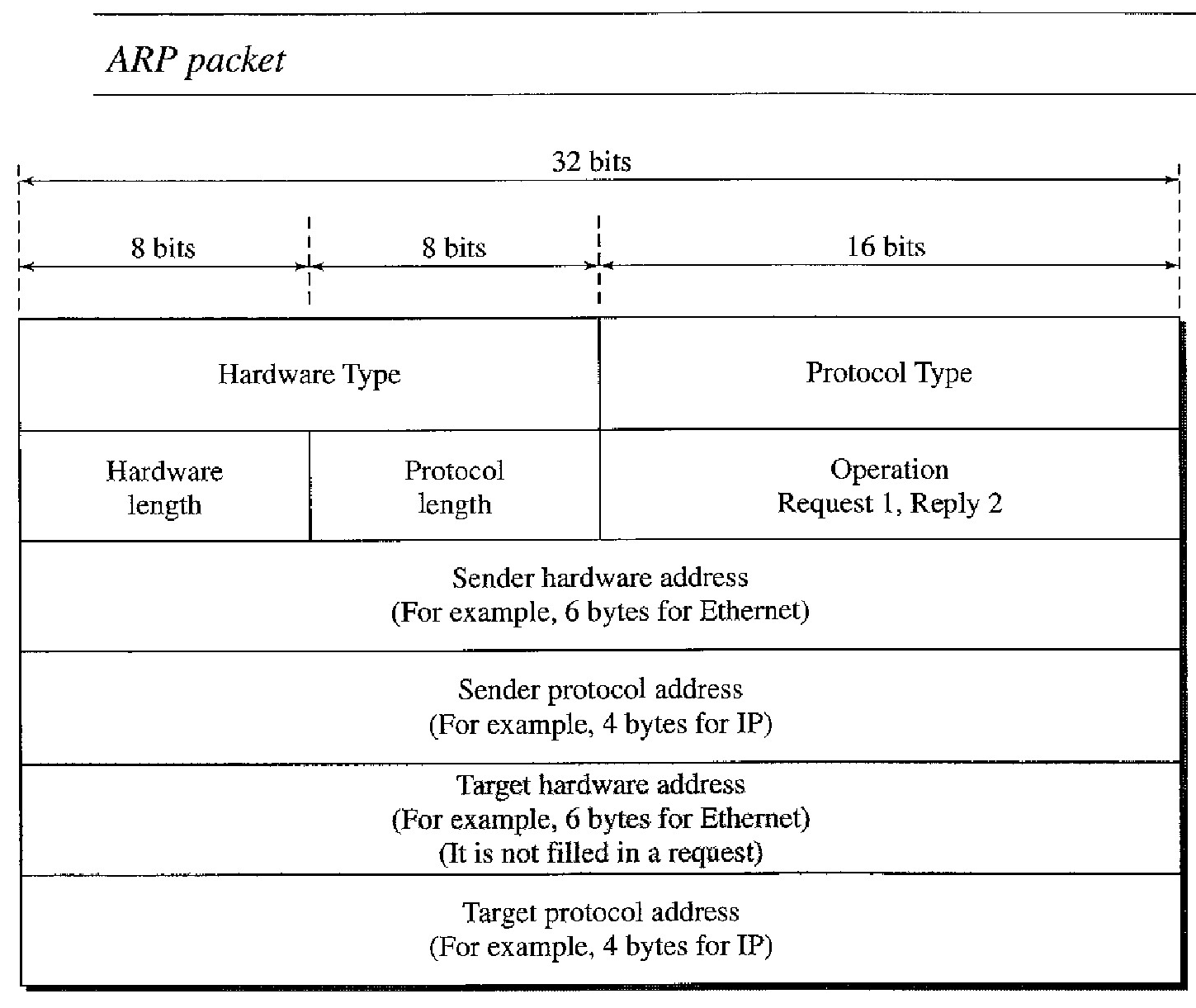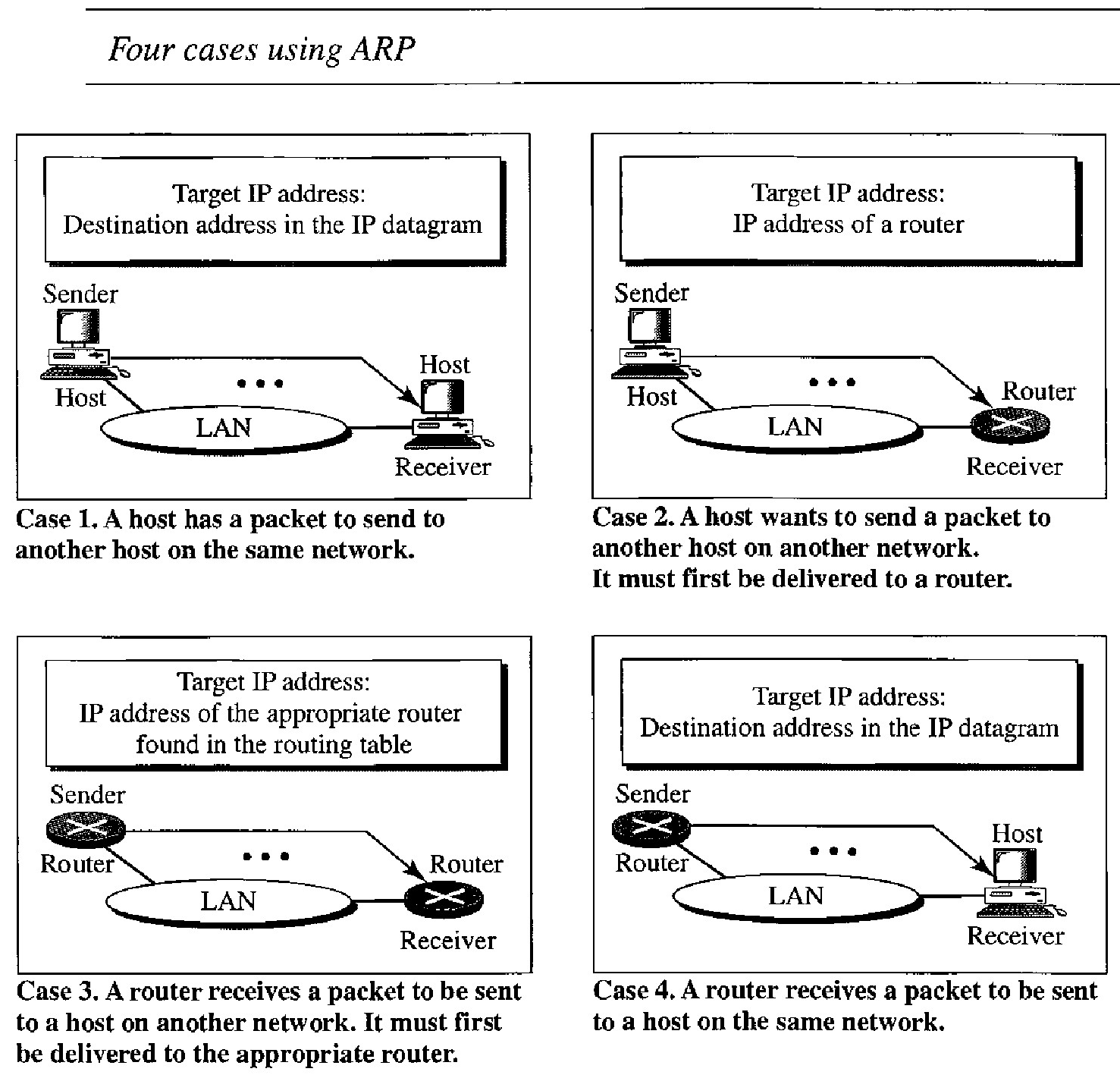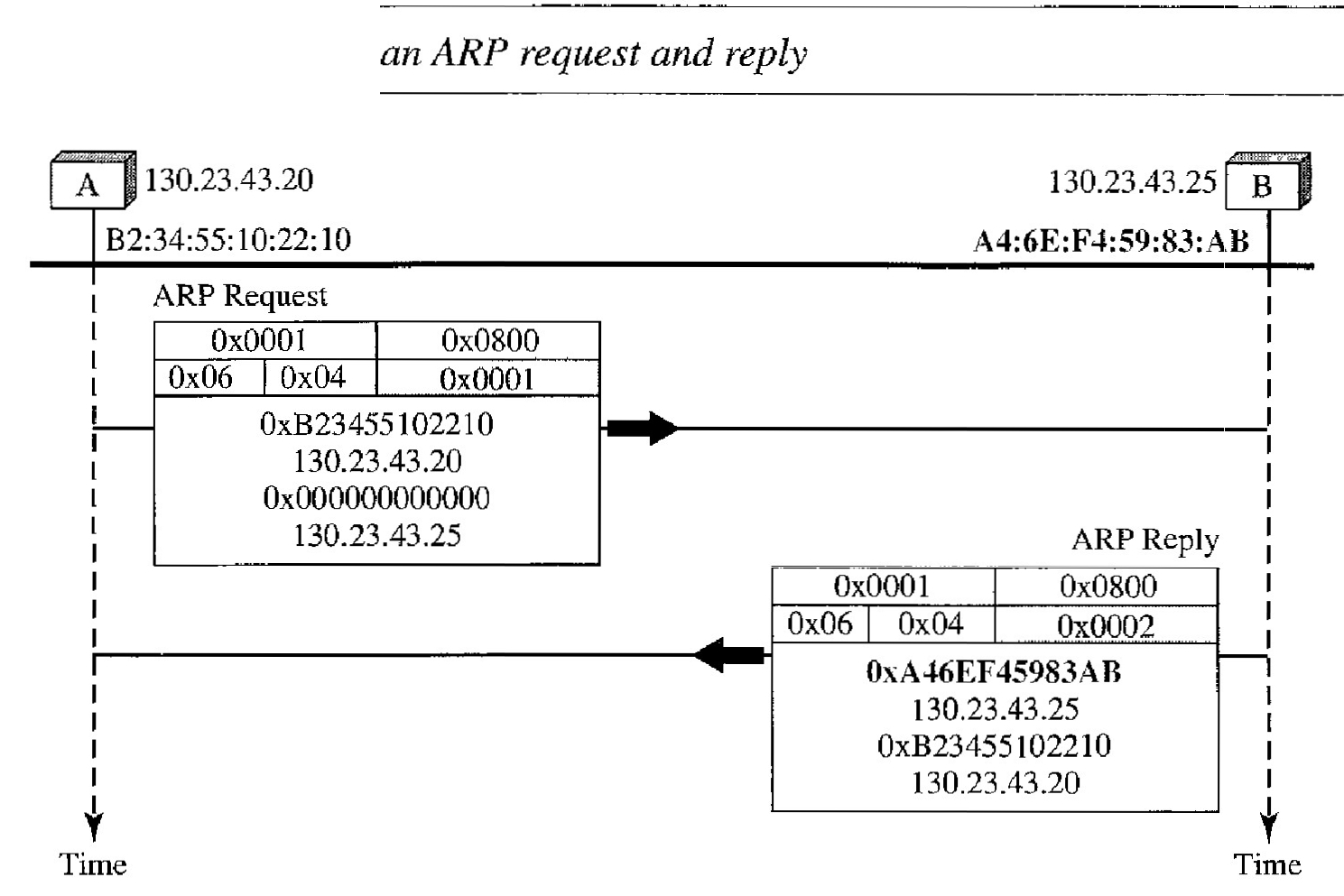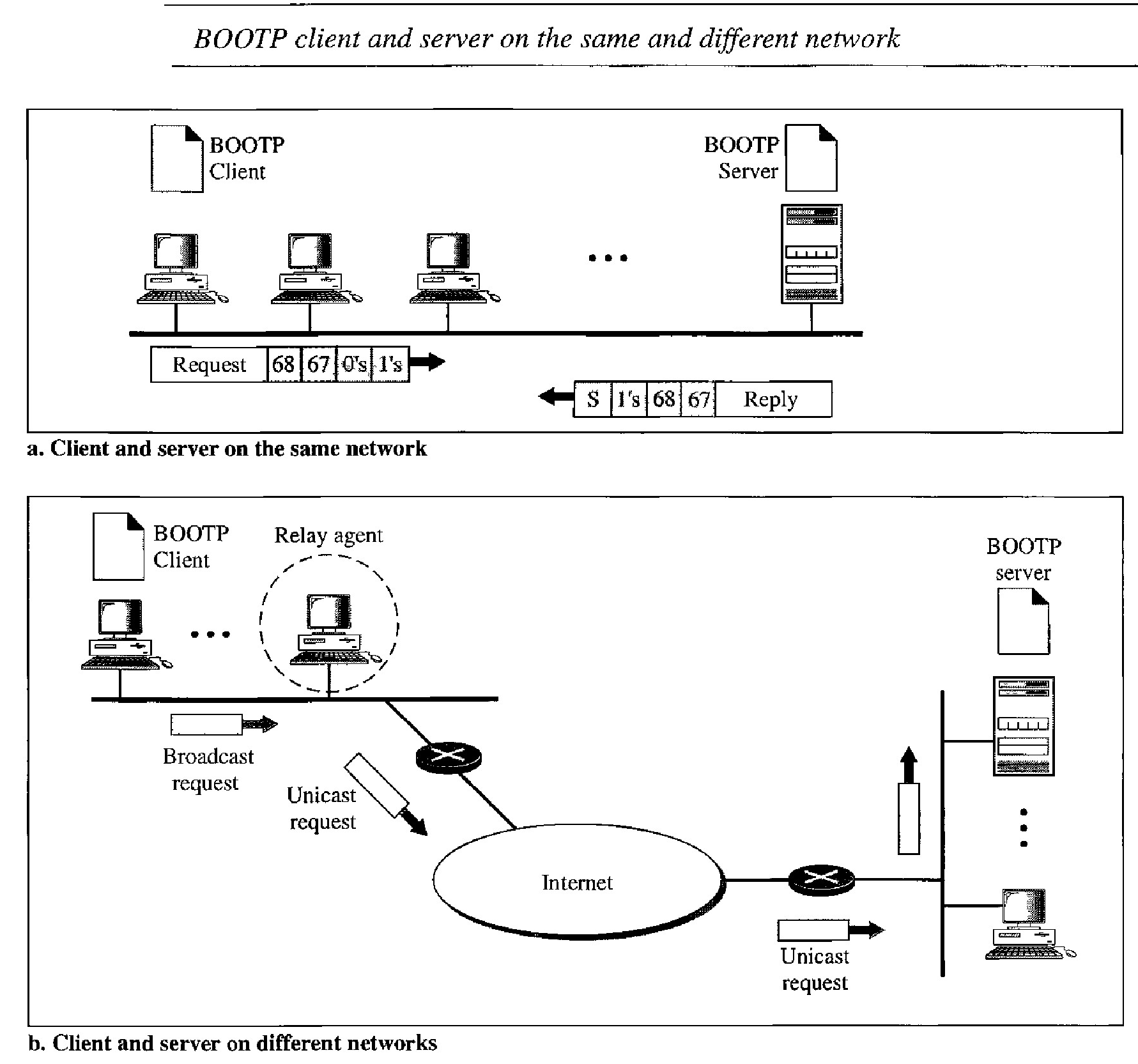The Internet Protocol (IP) is the main protocol at the network layer. IP was designed as a best-effort delivery protocol, but it lacks some features such as flow control and error control. It is a host-to-host protocol using logical addressing.
To make IP more responsive to some requirements in today's internetworking, we need the help of other protocols.
We need protocols to create a mapping between physical and logical addresses. IP packets use logical (host-to-host) addresses. These packets, however, need to be encap- sulated in a frame, which needs physical addresses (node-to-node). A protocol called ARP, the Address Resolution Protocol, is designed for this purpose.
We sometimes need reverse mapping-mapping a physical address to a logical address. For example, when booting a diskless network or leasing an IP address to a host. Three protocols are designed for this purpose: RARP, BOOTP, and DHCP.
Lack of flow and error control in the Internet Protocol has resulted in another protocol, ICMP, that provides alerts. It reports congestion and some types of errors in the network or destination host.
IP was originally designed for unicast delivery, one source to one destination. As the Internet has evolved, the need for multicast delivery, one source to many destinations, has increased tremendously. IGMP gives IP a multicast capability. ICMPv6, which will be operational when IPv6 is operational is another advanced protocol. ICMPv6 combines ARP, ICMP, and IGMP in one protocol.
ADDRESS MAPPING
An internet is made of a combination of physical networks connected by internetworking devices such as routers. A packet starting from a source host may pass through several different physical networks before finally reaching the destination host. The hosts and routers are recognized at the network level by their logical (IP) addresses.
However, packets pass through physical networks to reach these hosts and routers. At the physical level, the hosts and routers are recognized by their physical addresses.
A physical address is a local address. Its jurisdiction is a local network. It must be unique locally, but is not necessarily unique universally. It is called a physical address because it is usually (but not always) implemented in hardware. An example of a physical address is the 48-bit MAC address in the Ethernet protocol, which is imprinted on the NIC installed in the host or router.
The physical address and the logical address are two different identifiers. We need both because a physical network such as Ethernet can have two different protocols at the network layer such as IP and IPX (Novell) at the same time. Likewise, a packet at a network layer such as IP may pass through different physical networks such as Ethernet and LocalTalk (Apple).
This means that delivery of a packet to a host or a router requires two levels of addressing: logical and physical. We need to be able to map a logical address to its corresponding physical address and vice versa. These can be done by using either static or dynamic mapping.
Static mapping involves in the creation of a table that associates a logical address with a physical address. This table is stored in each machine on the network. Each machine that knows, for example, the IP address of another machine but not its physical address can look it up in the table. This has some limitations because physical addresses may change in the following ways:
A machine could change its NIC, resulting in a new physical address.
In some LANs, such as LocalTalk, the physical address changes every time the computer is turned on.
A mobile computer can move from one physical network to another, resulting in a change in its physical address.
To implement these changes, a static mapping table must be updated periodically. This overhead could affect network performance. In dynamic mapping each time a machine knows one of the two addresses (logical or physical), it can use a protocol to find the other one.
Mapping Logical to Physical Address: ARP
Anytime a host or a router has an IP datagram to send to another host or router, it has the logical (IP) address of the receiver. The logical (IP) address is obtained from the DNS if the sender is the host or it is found in a routing table if the sender is a router.
But the IP datagram must be encapsulated in a frame to be able to pass through the physical network. This means that the sender needs the physical address of the receiver.
The host or the router sends an ARP query packet. The packet includes the physical and IP addresses of the sender and the IP address of the receiver. Because the sender does not know the physical address of the receiver, the query is broadcast over the network.
Every host or router on the network receives and processes the ARP query packet, but only the intended recipient recognizes its IP address and sends back an ARP response packet. The response packet contains the recipient's IP and physical addresses. The packet is unicast directly to the inquirer by using the physical address received in the query packet.
In Figure above, the system on the left (A) has a packet that needs to be delivered to another system (B) with IP address 141.23.56.23. System A needs to pass the packet to its data link layer for the actual delivery, but it does not know the physical address of the recipient. It uses the services of ARP by asking the ARP protocol to send a broadcast ARP request packet to ask for the physical address of a system with an IP address of 141.23.56.23.
This packet is received by every system on the physical network, but only system B will answer it, as shown in second Figure above. System B sends an ARP reply packet that includes its physical address. Now system A can send all the packets it has for this destination by using the physical address it received.
Using ARP is inefficient if system A needs to broadcast an ARP request for each IP packet it needs to send to system B. It could have broadcast the IP packet itself. ARP can be useful if the ARP reply is cached (kept in cache memory for a while) because a system normally sends several packets to the same destination. A system that receives an ARP reply stores the mapping in the cache memory and keeps it for 20 to 30 minutes unless the space in the cache is exhausted. Before sending an ARP request, the system first checks its cache to see if it can find the mapping. An ARP request is broadcast; an ARP reply is unicast.

The format of an ARP packet.
Hardware type : This is a 16-bit field defining the type of the network on which ARP is running. Each LAN has been assigned an integer based on its type. For example, Ethernet is given type 1. ARP can be used on any physical network.
Protocol type : This is a 16-bit field defining the protocol. For example, the value of this field for the IPv4 protocol is 080016, ARP can be used with any higher-level protocoL
Hardware length : This is an 8-bit field defining the length of the physical address in bytes. For example, for Ethernet the value is 6.
Protocol length : This is an 8-bit field defining the length of the logical address in bytes. For example, for the IPv4 protocol the value is 4.
Operation : This is a 16-bit field defining the type of packet. Two packet types are defined: ARP request (1) andARP reply (2).
Sender hardware address : This is a variable-length field defining the physical address of the sender. For example, for Ethernet this field is 6 bytes long.
Sender protocol address : . This is a variable-length field defining the logical (for example, IP) address of the sender. For the IP protocol, this field is 4 bytes long.
Target hardware address : This is a variable-length field defining the physical address of the target. For example, for Ethernet this field is 6 bytes long. For an ARP request message, this field is all Osbecause the sender does not know the physical address of the target.
Target protocol address : This is a variable-length field defining the logical (for example, IP) address of the target. For the IPv4 protocol, this field is 4 bytes long.

Encapsulation of ARP packet
An ARP packet is encapsulated directly into a data link frame. Note that the type field indicates that the data carried by the frame are an ARP packet.
These are the steps involved in an ARP process:
The sender knows the IP address of the target.
IP asks ARP to create an ARP request message, filling in the sender physical address, the sender IP address, and the target IP address. The target physical address field is filled with Os.
The message is passed to the data link layer where it is encapsulated in a frame by using the physical address of the sender as the source address and the physical broadcast address as the destination address.
Every host or router receives the frame. Because the frame contains a broadcast destination address, all stations remove the message and pass it to ARP. All machines except the one targeted drop the packet. The target machine recognizes its IP address.
The target machine replies with an ARP reply message that contains its physical address. The message is unicast.
The sender receives the reply message. It now knows the physical address of the target machine.
The IP datagram, which carries data for the target machine, is now encapsulated in a frame and is unicast to the destination.
Four different cases in which the services of ARP can be used
The sender is a host and wants to send a packet to another host on the same net- work. In this case, the logical address that must be mapped to a physical address is the destination IP address in the datagram header.
The sender is a host and wants to send a packet to another host on another network. In this case, the host looks at its routing table and finds the IP address of the next hop (router) for this destination. If it does not have a routing table, it looks for the IP address of the default router. The IP address of the router becomes the logical address that must be mapped to a physical address
The sender is a router that has received a datagram destined for a host on another network. It checks its routing table and finds the IP address of the next router. The IP address of the next router becomes the logical address that must be mapped to a physical address.
The sender is a router that has received a datagram destined for a host on the same network. The destination IP address of the datagram becomes the logical address that must be mapped to a physical address.

Q. A host with IP address 130.23.43.20 and physical address B2:34:55: 10:22: 10 has a packet to send to another host with IP address 130.23.43.25 and physical address A4:6E:F4:59:83:AB (which is unknown to the first host). The two hosts are on the same Ethernet network. Show the ARP request and reply packets encapsulated in Ethernet frames.
Note that the ARP data field in this case is 28 bytes, and that the individual addresses do not fit in the 4-byte boundary. That is why we do not show the regular 4-byte boundaries for these addresses.

Mapping Physical to Logical Address: RARP, BOOTP, and DHCP
There are occasions in which a host knows its physical address, but needs to know its logical address. This may happen in two cases:
A diskless station is just booted. The station can find its physical address by checking its interface, but it does not know its IP address.
An organization does not have enough IP addresses to assign to each station; it needs to assign IP addresses on demand. The station can send its physical address and ask for a short time lease.
Reverse Address Resolution Protocol (RARP)
Reverse Address Resolution Protocol (RARP) finds the logical address for a machine that knows only its physical address.
Each host or router is assigned one or more logical (IP) addresses, which are unique and independent of the physical (hardware) address of the machine.
To create an IP datagram, a host or a router needs to know its own IP address or addresses. The IP address of a machine is usually read from its configuration file stored on a disk file.
However, a diskless machine is usually booted from ROM, which has minimum booting information. The ROM is installed by the manufacturer. It cannot include the IP address because the IP addresses on a network are assigned by the network administrator.
The machine can get its physical address (by reading its NIC, for example), which is unique locally. It can then use the physical address to get the logical address by using the RARP protocol.
A RARP request is created and broadcast on the local network. Another machine on the local network that knows all the IP addresses will respond with a RARP reply. The requesting machine must be running a RARP client program; the responding machine must be running a RARP server program.
There is a serious problem with RARP: Broadcasting is done at the data link layer. The physical broadcast address, all 1's in the case of Ethernet, does not pass the boundaries of a network.
This means that if an administrator has several networks or several subnets, it needs to assign a RARP server for each network or subnet. This is the reason that RARP is almost obsolete. Two protocols, BOarp and DHCp, are replacing RARP.
Bootstrap Protocol (BOOTP)
The Bootstrap Protocol (BOOTP) is a client/server protocol designed to provide physical address to logical address mapping. BOOTP is an application layer protocol.
The administrator may put the client and the server on the same network or on different networks.
BOOTP messages are encapsulated in a UDP packet, and the UDP packet itself is encapsulated in an IP packet.
Although a client sends an IP datagram, it knows neither its own IP address (the source address) nor the server's IP address (the destination address). The client simply uses all Os as the source address and allIs as the destination address.
One of the advantages of BOOTP over RARP is that the client and server are application-layer processes. As in other application-layer processes, a client can be in one network and the server in another, separated by several other networks.
The BOOTP request is broadcast because the client does not know the IP address of the server. A broadcast IP datagram cannot pass through any router. To solve the problem, there is a need for an intermediary. One of the hosts (or a router that can be configured to operate at the application layer) can be used as a relay. The host in this case is called a relay agent.
The relay agent knows the unicast address of a BOOTP server. When it receives this type of packet, it encapsulates the message in a unicast datagram and sends the request to the BOOTP server.
The packet carrying a unicast destination address, is routed by any router and reaches the BOOTP server.
The BOOTP server knows the message comes from a relay agent because one of the fields in the request message defines the IP address of the relay agent. The relay agent, after receiving the reply, sends it to the BOOTP client.

Dynamic Host Configuration Protocol (DHCP)
BOOTP is not a dynamic configuration protocol. When a client requests its IP address, the BOOTP server consults a table that matches the physical address of the client with its IP address. This implies that the binding between the physical address and the IP address of the client already exists. The binding is predetermined.
However, what if a host moves from one physical network to another? What if a host wants a temporary IP address? BOOTP cannot handle these situations because the binding between the physical and IP addresses is static and fixed in a table until changed by the administrator. BOOTP is a static configuration protocol.
The Dynamic Host Configuration Protocol (DHCP) has been devised to provide static and dynamic address allocation that can be manual or automatic.
Static Address Allocation : DHCP is backward compatible with BOOTP, which means a host running the BOOTP client can request a static address from a DHCP server. A DHCP server has a database that statically binds physical addresses to IP addresses.
Dynamic Address Allocation : DHCP has a second database with a pool of available IP addresses. This second database makes DHCP dynamic. When a DHCP client requests a temporary IP address, the DHCP server goes to the pool of available (unused) IP addresses and assigns an IP address for a negotiable period of time.
When a DHCP client sends a request to a DHCP server, the server first checks its static database. If an entry with the requested physical address exists in the static database, the permanent IP address of the client is returned. If the entry does not exist in the static database, the server selects an IP address from the available pool, assigns the address to the client, and adds the entry to the dynamic database.
The dynamic aspect of DHCP is needed when a host moves from network to network or is connected and disconnected from a network.
The addresses assigned from the pool are temporary addresses. The DHCP server issues a lease for a specific time. When the lease expires, the client must either stop using the IP address or renew the lease. The server has the option to agree or disagree with the renewal. If the server disagrees, the client stops using the address.
Manual and Automatic Configuration : One major problem with the BOOTP protocol is that the table mapping the IP addresses to physical addresses needs to be manually configured. This means that every time there is a change in a physical or IP address, the administrator needs to manually enter the changes. DHCP, on the other hand, allows both manual and automatic configurations. Static addresses are created manually; dynamic addresses are created automatically.